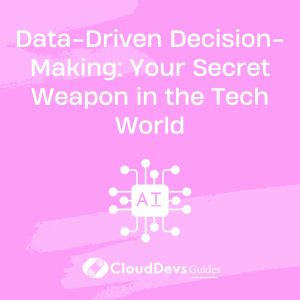Data-Driven Decision-Making: Your Secret Weapon in the Tech World
In the ever-evolving landscape of technology and business, staying ahead of the curve is essential. For early-stage startup founders, VC investors, and tech leaders, making informed decisions can be the key to success. In this article, we delve into the realm of AI development and predictive analytics, exploring how they empower businesses to outperform the competition.
1. The Power of Predictive Analytics
Predictive analytics is the art and science of using historical and current data to forecast future events or trends. It’s like having a crystal ball for your business decisions. Let’s dive into a few examples to illustrate its potential:
1.1. Sales Forecasting
Imagine you’re an e-commerce startup founder. Predictive analytics can help you anticipate sales trends, adjusting inventory and marketing strategies accordingly. For instance, by analyzing past data on consumer behavior, you can predict which products will be in high demand during the holiday season. This knowledge allows you to optimize your supply chain and marketing efforts, ensuring that you meet customer demand and maximize profits.
1.2. Customer Churn Prediction
VC investors often scrutinize subscription-based startups. Predictive analytics can provide insights into customer behavior, allowing you to identify early signs of potential churn. By analyzing usage patterns, customer interactions, and feedback, you can proactively address issues, improve your product or service, and retain valuable customers.
1.3. Risk Management in Financial Services
Tech leaders in the finance sector rely heavily on predictive analytics to manage risk. By analyzing vast amounts of financial data, AI algorithms can identify potential credit risks, fraudulent activities, and market fluctuations. This information empowers financial institutions to make informed decisions, protect their assets, and outperform competitors.
2. The Role of AI in Predictive Analytics
Now, let’s discuss the role of Artificial Intelligence (AI) in predictive analytics. AI technologies, including machine learning and deep learning, have revolutionized predictive modeling. They can process enormous datasets, identify complex patterns, and continuously adapt to changing circumstances. Here are a few examples of how AI enhances predictive analytics:
2.1. Personalized Recommendations
In the age of Netflix and Amazon, personalization is king. AI algorithms analyze users’ past behavior, preferences, and interactions to recommend products, movies, or content tailored to their tastes. This not only enhances the user experience but also drives sales and engagement.
2.2. Fraud Detection
Financial institutions employ AI-powered predictive models to detect fraudulent transactions in real-time. By analyzing transaction patterns and user behavior, AI can flag suspicious activities and prevent potential fraud, saving millions of dollars in losses.
2.3. Healthcare Predictive Analytics
AI is transforming the healthcare industry by predicting patient outcomes, disease outbreaks, and treatment effectiveness. Machine learning models can analyze medical records, genomic data, and clinical notes to assist doctors in making more accurate diagnoses and treatment plans.
3. Key Considerations for Implementing AI and Predictive Analytics
Implementing AI and predictive analytics in your startup or organization requires careful planning. Here are some key considerations:
- Data Quality
The accuracy of predictions depends on the quality and quantity of data. Ensure your data collection methods are robust and reliable. Clean and well-organized data is the foundation of effective predictive analytics.
- Talent Acquisition
Building AI models and predictive analytics tools requires skilled professionals. Consider hiring data scientists, machine learning engineers, and data engineers who can develop and maintain these systems.
- Ethical Considerations
As AI makes decisions that impact people’s lives, it’s crucial to consider ethical implications. Be transparent about how AI is used and ensure it aligns with your brand values.
4 .External Resources for Further Reading
To delve deeper into AI development and predictive analytics, check out these external resources:
- Harvard Business Review – How to Put Data Analytics to Work – https://hbr.org/2018/11/how-to-put-data-analytics-to-work
- MIT Sloan Review – “The Future of Predictive Analytics in Business https://sloanreview.mit.edu/article/the-future-of-predictive-analytics-in-business/
- Forbes – The Role of Artificial Intelligence in Predictive Analytics
Table of Contents









